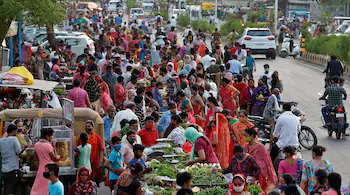Eight years on, GST has gained strong approval. GST has lowered tax rates on essentials, unified India’s market, reduced logistics costs and boosted inter-state trade, benefiting both consumers and businesses through simplification and digitisation

GST fulfilled the decades-old dream of economic integration.
By Pradeep Bhandari
When the clock struck midnight on July 1, 2017, India witnessed a historic transformation—ushered in by Prime Minister Narendra Modi with unmatched conviction and clarity. The launch of the Goods and Services Tax (GST) was not just a tax reform; it was the laying of a new foundation for India’s economic architecture—seamless, transparent, and future-ready.
PM Modi’s vision was rooted in the belief that One Nation, One Tax wasn’t just a slogan; it was the path to economic justice, efficiency, and national unity. GST fulfilled the decades-old dream of economic integration—a dream first envisioned by Sardar Vallabhbhai Patel when he stitched together the nation politically.
That dream was rekindled by Shri Atal Bihari Vajpayee in 2000, who proposed the GST framework and established the Empowered Committee of State Finance Ministers. Yet it took the resolve, consensus-building capacity, and political will of Narendra Modi to convert that vision into reality.
Under Congress rule, GST remained an idea stuck in files. The UPA government lacked the courage to bring states together or dismantle the corrupt maze of multiple taxes. It was Prime Minister Modi who took ownership of reform, convinced all states across party lines, and passed the 101st Constitutional Amendment. Within just two years of introducing it in Parliament in 2014, GST was ratified by more than half of Indian states and finally rolled out in 2017—one of the fastest and boldest tax overhauls in global history.
Eight years later, the results speak for themselves. The recently released Deloitte GST@8 report confirms what every honest business owner in India already knows: GST has changed the game. 85% of Indian businesses now hold a positive perception of GST, a stunning leap from just 59% in 2022. Among MSMEs—the backbone of our economy—satisfaction levels have risen from 78% to 82% in a single year. Nearly 99% of businesses are now digitally prepared for GST audits, showing how the reform has accelerated formalisation and digitisation.
Contrast this with the era of Inspector Raj under Congress rule—when businesses feared harassment, bribes, and bureaucratic hurdles. GST has eliminated those barriers, replacing corruption with compliance, and chaos with clarity. PM Modi’s reform has made the tax system fully IT-driven, with minimal human interference, ensuring transparency and efficiency at every step.
The benefits to the common man have been equally profound. GST brought down the overall tax burden on everyday items. While the average pre-GST indirect tax rate hovered around 15%, the average GST rate has dropped to 12.2% as of March 2023. Essential goods—like soaps, hair oils, and household appliances—have seen their tax rates cut drastically. Movie tickets, too, are now more affordable. A study by NIPFP confirms that 60% of consumption items attract GST rates of 5% or lower, with just 3% in the highest 28% bracket. This is tax reform with a pro-poor, pro-people approach.
For businesses, GST has been a revolution. It has replaced 17 taxes and 13 cesses with a single, harmonised tax. Earlier, each state was a separate market. Now, India is one unified economic space. Check-posts at borders have vanished, thanks to the e-way bill system, enabling trucks to travel 44% more daily and slashing logistics costs. As a result, inter-state trade rose to 35% of GDP in FY22, up from 23.5% in FY18.
MSMEs have gained like never before. Over 44 lakh small taxpayers now benefit from the Quarterly Returns with Monthly Payment (QRMP) scheme. Platforms like TReDS, e-invoicing, and the Account Aggregator framework have expanded access to credit. India now has over 1.4 crore registered taxpayers, up from just 65 lakhs in 2017—a testament to how GST has expanded the formal economy.
Importantly, GST is a triumph of cooperative federalism—a model perfected by PM Modi. The GST Council, where two-thirds voting power rests with states, has held 53 meetings, with nearly all decisions taken by consensus. This is proof that PM Modi’s leadership doesn’t impose—it inspires unity. States are not losers in this reform; they are beneficiaries. They retain 100% of SGST, receive 50% of IGST, and even 42% of CGST is devolved to them as per Finance Commission recommendations.
The data is clear: tax buoyancy improved from 0.72 before GST to 1.22 during 2018–23. Even after the COVID-19 pandemic and compensation cessation, state revenues remain buoyant at 1.15. Between FY18 and FY24, states would have earned Rs 37.5 lakh crore under the old regime. Under GST, they earned Rs 46.56 lakh crore—a significant gain.
Yes, some challenges remain. Refund delays, compliance effort, and audits need continued refinement. But the difference is that today, industry speaks in the language of solutions—not complaints. For instance, 90% of Deloitte respondents recommended automated refund interest payments—a forward-looking, constructive ask.
The truth is undeniable: GST has empowered the taxpayer, energised the economy, and elevated India’s global standing. International experts now cite India’s GST model as a benchmark in tax reform.
Congress had decades but delivered nothing beyond empty talk. Under PM Modi, in just eight years, GST has turned India into a unified, digitally empowered, and growth-ready economy.
This is not just a tax story—it is the story of New India, rising confidently under the dynamic leadership of Narendra Modi. As we mark eight years of GST, we don’t just celebrate a reform—we salute the visionary who made it possible.
Published – July 01, 2025
Source : https://www.moneycontrol.com/
Disclaimer: This information has been collected through secondary research and ceruleconsulting.com is not responsible for any errors in the same
